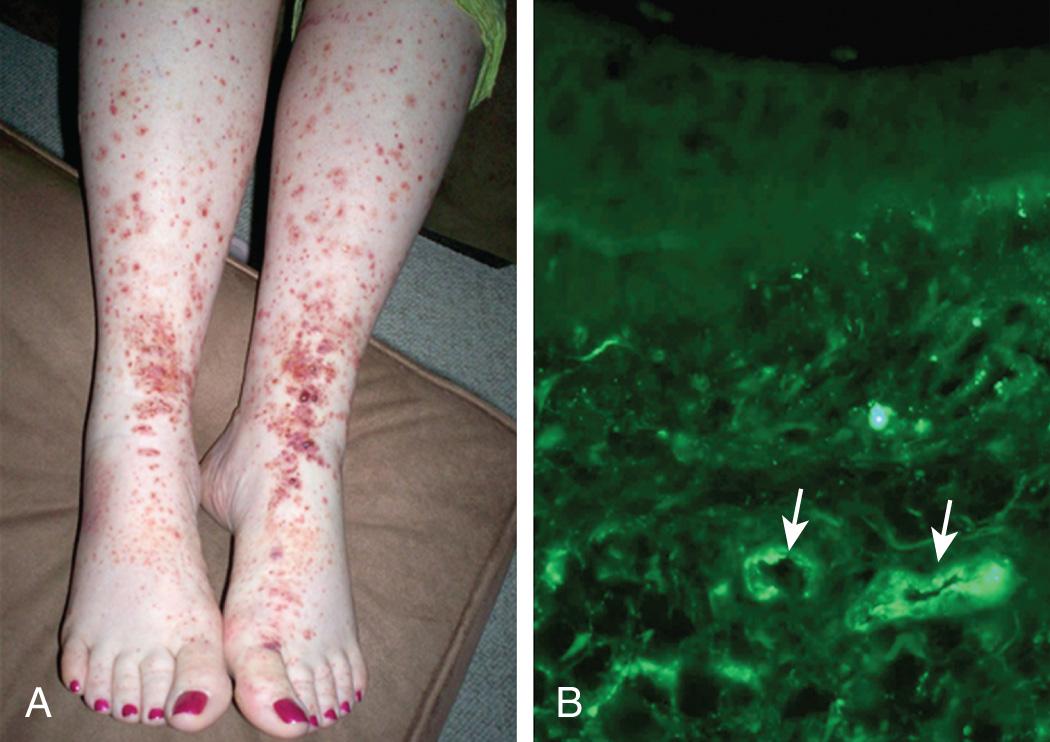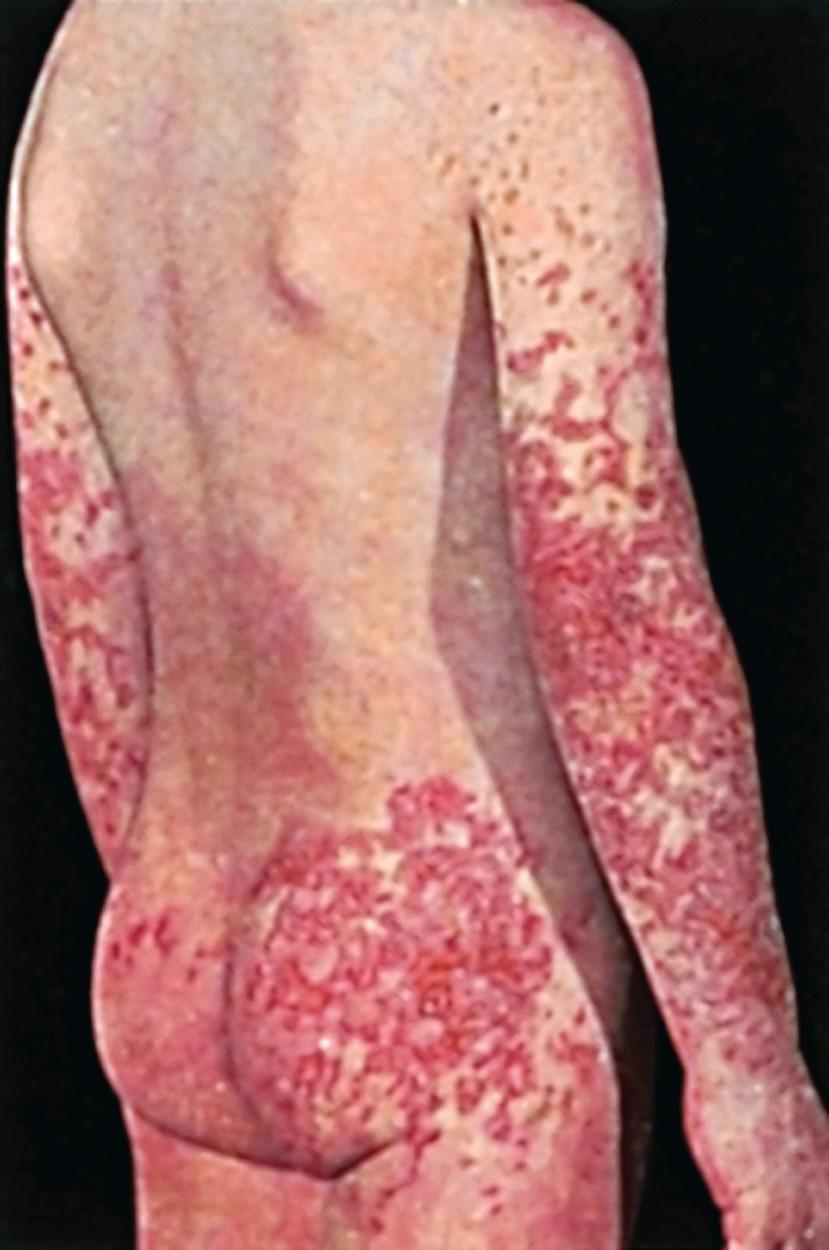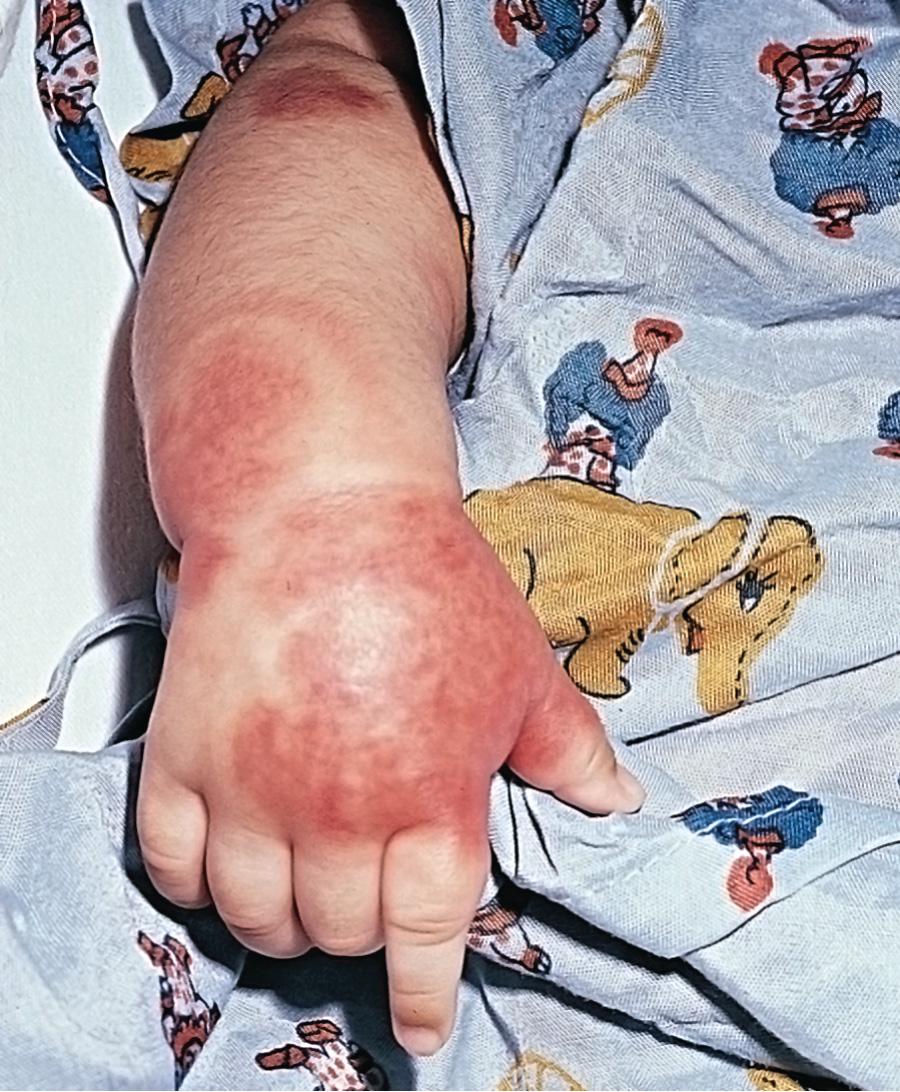Physical Address
304 North Cardinal St.
Dorchester Center, MA 02124
Childhood vasculitis encompasses a broad spectrum of diseases that share inflammation of the blood vessels as the central pathophysiology. The pathogenesis of the vasculitides is generally idiopathic. Some forms of vasculitis are associated with infectious agents and medications, whereas others may occur in the setting of preexisting autoimmune disease. The pattern of vessel injury provides insight into the form of vasculitis and serves as a framework to delineate the different vasculitic syndromes. The distribution of vascular injury includes small vessels (capillaries, arterioles, and postcapillary venules), medium vessels (renal arteries, mesenteric vasculature, and coronary arteries), and large vessels (the aorta and its proximal branches) ( Fig. 192.1 ). Additionally, some forms of small vessel vasculitis are characterized by the presence of antineutrophil cytoplasmic antibodies (ANCAs) , whereas others are associated with immune complex deposition in affected tissues. A combination of clinical features, histologic appearance of involved vessels, and laboratory data is used to classify vasculitis ( Tables 192.1 to 192.3 ). A nomenclature system from the 2012 International Chapel Hill Consensus Conference has proposed using the pathologic diagnosis rather than eponyms for vasculitis nomenclature. For example, Henoch-Schönlein purpura would be referred to as IgA vasculitis. Additionally, the classification criteria endorsed by the European League Against Rheumatism, Pediatric Rheumatology International Trial Organization, and Pediatric Rheumatology European Society (EULAR/ PRINTO/PRES) have been validated in childhood vasculitis. ( Table 192.1 ).
2012 Chapel Hill Consensus Conference Nomenclature of Vasculitides
|
EUROPEAN LEAGUE AGAINST RHEUMATISM/PEDIATRIC RHEUMATOLOGY EUROPEAN SOCIETY Classification of Childhood Vasculitis
|
Fever, weight loss, fatigue of unknown origin
Skin lesions (palpable purpura, fixed urticaria, livedo reticularis, nodules, ulcers)
Neurologic lesions (headache, mononeuritis multiplex, focal central nervous system lesions)
Arthralgia or arthritis, myalgia, or myositis, serositis
Hypertension, hematuria, renal failure
Pulmonary infiltrates or hemorrhage
Myocardial ischemia, arrhythmias
Increased erythrocytes sedimentation rate or C-reactive protein level
Leukocytosis, anemia, thrombocytosis
Eosinophilia
Antineutrophil cytoplasmic antibodies
Elevated factor VIII–related antigen (von Willebrand factor)
Cryoglobulinemia
Circulating immune complexes
Hematuria
| SYNDROME | FREQUENCY | VESSELS AFFECTED | CHARACTERISTIC PATHOLOGY |
|---|---|---|---|
| Polyarteritis | |||
| Polyarteritis nodosa | Rare | Medium-size and small muscular arteries and sometimes arterioles | Focal segmental (often near bifurcations); fibrinoid necrosis; gastrointestinal, renal microaneurysms; lesions at various stages of evolution |
| Kawasaki disease | Common | Coronary and other muscular arteries | Thrombosis, fibrosis, aneurysms, especially of coronary vessels |
| Leukocytoclastic Vasculitis | |||
| Henoch-Schönlein purpura (IgA vasculitis) | Common | Arterioles and venules, often small arteries and veins | Leukocytoclasis; mixed cells, eosinophils, IgA deposits in affected vessels |
| Hypersensitivity angitis | Rare | Arterioles and venules | Leukocytoclastic or lymphocytic, varying eosinophils, occasionally granulomatous; widespread lesions at same stage of evolution |
| Granulomatous Vasculitis | |||
| Granulomatosis with polyangiitis (Wegener granulomatosis) | Rare | Small arteries and veins, occasionally larger vessels | Upper and lower respiratory tract, necrotizing granulomata glomerulonephritis |
| Eosinophilic granulomatosis with polyangiitis (Churg-Strauss syndrome) | Rare | Small arteries and veins, often arterioles and venules | Necrotizing extravascular granulomata; lung involvement; eosinophilia |
| Giant Cell Arteritis | |||
| Takayasu arteries | Uncommon | Large arteries | Granulomatous inflammation, giant cells; aneurysms, dissection |
| Temporal arteritis | Rare | Medium-size and large arteries | Granulomatous inflammation, giant cell arteries |
Childhood vasculitis varies from a relatively benign and self-limited disease such as Henoch-Schönlein purpura to catastrophic disease with end-organ damage, as seen in granulomatosis with polyangiitis (formerly Wegener granulomatosis). Vasculitis generally manifests as a heterogeneous multisystem disease. Although some features, such as purpura, are easily identifiable, others, such as hypertension secondary to renal artery occlusion or glomerulonephritis, can be subtler. Ultimately, the key to recognizing vasculitis relies heavily on pattern recognition. Demonstration of vessel injury and inflammation on biopsy or vascular imaging is required to confirm a diagnosis of vasculitis.
Henoch-Schönlein purpura ( HSP ) is the most common vasculitis of childhood and is characterized by leukocytoclastic vasculitis and immunoglobulin A deposition in the small vessels in the skin, joints, gastrointestinal tract, and kidney. According to the 2012 International Chapel Hill Consensus Conference nomenclature, HSP is also referred to as IgA vasculitis , based on the presence of vasculitis with predominance of IgA deposits affecting small vessels.
HSP occurs worldwide and affects all ethnic groups but is more common in white and Asian populations. The incidence of HSP is estimated at 14-20 per 100,000 children per year and affects males more than females, with a 1.2-1.8 : 1 male/female ratio. Approximately 90% of HSP cases occur in children, usually between ages 3 and 10 yr. HSP is distinctly less common in adults, who often have severe and chronic complications. HSP is more common in the winter and spring and is unusual in summer months. Many cases of HSP follow a documented upper respiratory infection.
Skin biopsies demonstrate leukocytoclastic vasculitis of the dermal capillaries and postcapillary venules. The inflammatory infiltrate includes neutrophils and monocytes. Renal histopathology typically shows endocapillary proliferative glomerulonephritis, ranging from a focal segmental process to extensive crescentic involvement. In all tissues, immunofluorescence identifies IgA deposition in walls of small vessels ( Fig. 192.2 ), accompanied to a lesser extent by deposition of C3, fibrin, and IgM.

The exact pathogenesis of HSP remains unknown. Given the seasonality of HSP and the frequency of preceding upper respiratory infections, infectious triggers such as group A β-hemolytic streptococcus, Staphylococcus aureus, mycoplasma, and adenovirus have been suspected. The common finding of deposition of IgA, specifically IgA 1 , suggests that HSP is a disease mediated by IgA and IgA immune complexes. HSP occasionally clusters in families, suggesting a genetic component. HLA-B34 and HLA-DRB1*01 alleles have been linked to HSP nephritis. Patients with familial Mediterranean fever, hereditary periodic fever syndromes, and complement deficiencies are at increased risk for developing HSP, suggesting that genetically determined immune dysregulation may contribute.
The hallmark of HSP is its rash : palpable purpura starting as pink macules or wheals and developing into petechiae, raised purpura, or larger ecchymoses. Occasionally, bullae and ulcerations develop. The skin lesions are usually symmetric and occur in gravity-dependent areas (lower extremities), extensor aspect of the upper extremities or on pressure points (buttocks) ( Figs. 192.2 and 192.3 ). The skin lesions often evolve in groups, typically lasting 3-10 days, and may recur up to 4 mo after initial presentation. Subcutaneous edema localized to the dorsa of hands and feet, periorbital area, lips, scrotum, or scalp is also common.

Musculoskeletal involvement, including arthritis and arthralgias, is common, occurring in up to 75% of children with HSP. The arthritis tends to be self-limited and oligoarticular, with a predilection for large joints such as the knees and ankles, and does not lead to deformities. Periarticular swelling and tenderness without erythema or effusions are common. The arthritis usually resolves within 2 wk but can recur.
Gastrointestinal (GI) manifestations occur in up to 80% of children with HSP and include abdominal pain, vomiting, diarrhea, paralytic ileus, and melena. Intussusception, mesenteric ischemia, and intestinal perforation are rare but serious complications. Endoscopic evaluation is usually not needed but may identify vasculitis of the intestinal tract.
Renal involvement occurs in up to 30% of children with HSP, manifesting as microscopic hematuria, proteinuria, hypertension, frank nephritis, nephrotic syndrome, and acute or chronic renal failure. However, progression to end-stage renal disease (ESRD) is uncommon in children (1–2%) (see Chapter 538.3 ). Renal manifestations can be delayed for several months after the initial illness, so close follow-up with serial urinalyses and blood pressure monitoring is necessary.
Neurologic manifestations of HSP, caused by hypertension (posterior reversible encephalopathy syndrome) or central nervous system (CNS) vasculitis, may also occur, including intracerebral hemorrhage, seizures, headaches, depressed level of consciousness, cranial or peripheral neuropathies, and behavior changes. Other, less common potential manifestations of HSP are inflammatory eye disease, carditis, pulmonary hemorrhage, orchitis, and testicular torsion.
The diagnosis of HSP is clinical and often straightforward when the typical rash is present. However, in at least 25% of cases, the rash appears after other manifestations, making early diagnosis challenging. Table 192.4 summarizes the EULAR/PRES classification criteria for HSP. Most patients are afebrile.
* Classification criteria are developed for use in research and not validated for clinical diagnosis.
† Developed for use in pediatric populations only.
Palpable purpura (in absence of coagulopathy or thrombocytopenia) and 1 or more of the following criteria must be present:
Abdominal pain (acute, diffuse, colicky pain)
Arthritis or arthralgia
Biopsy of affected tissue demonstrating predominant IgA deposition
Renal involvement (proteinuria >.3 g/24 hr), hematuria or red cell casts
The differential diagnosis for HSP depends on specific organ involvement but usually includes other small vessel vasculitides, infections, acute poststreptococcal glomerulonephritis, hemolytic-uremic syndrome, coagulopathies, and other acute intraabdominal processes. Additional disorders in the differential include papular-purpuric glove and sock syndrome, systemic lupus erythematosus (SLE), other vasculitides (urticarial, hypersensitivity), and thrombocytopenia.
Infantile acute hemorrhagic edema (AHE) , an isolated cutaneous leukocytoclastic vasculitis that affects infants <2 yr of age, resembles HSP clinically. AHE manifests as fever; tender edema of the face, scrotum, hands, and feet; and ecchymosis (usually larger than the purpura of HSP) on the face and extremities ( Fig. 192.4 ). The trunk is spared, but petechiae may be seen in mucous membranes. The patient usually appears well except for the rash. The platelet count is normal or elevated, and the urinalysis results are normal. The younger age, the nature of the lesions, absence of other organ involvement, and a biopsy may help distinguish infantile AHE from HSP.

No laboratory finding is diagnostic of HSP. Common but nonspecific findings include leukocytosis, thrombocytosis, mild anemia, and elevations of erythrocyte sedimentation rate (ESR) and C-reactive protein (CRP). The platelet count is normal in HSP . Occult blood is frequently found in stool specimens. Serum albumin levels may be low because of renal or intestinal protein loss. Autoantibody testing such as antinuclear antibody (ANA) is not useful diagnostically except to exclude other diseases. Serum IgA values are often elevated but are not routinely measured. Assessment of renal involvement with blood pressure, urinalysis, and serum creatinine is necessary.
Ultrasound is often used in the setting of GI complaints to look for bowel wall edema or the rare occurrence of an associated intussusception. Barium enema can also be used to both diagnose and treat intussusception. Although often unnecessary in typical HSP, biopsies of skin and kidney can provide important diagnostic information, particularly in atypical or severe cases, and characteristically show leukocytoclastic vasculitis with IgA deposition in affected tissues.
Treatment for mild and self-limited HSP is supportive, with an emphasis on ensuring adequate hydration, nutrition, and analgesia. Corticosteroids are most often used to treat significant GI involvement or other life-threatening manifestations. Glucocorticoids such as oral prednisone (1-2 mg/kg/day), or in severe cases, intravenous (IV) methylprednisolone for 1-2 wk, followed by taper, reduce abdominal and joint pain but do not alter overall prognosis. Corticosteroids are not routinely recommended for prevention of complications such as nephritis. Rapid tapering of corticosteroids may lead to a flare of HSP symptoms. Although few data are available to demonstrate efficacy, intravenous immune globulin (IVIG) and plasma exchange are sometimes used for severe disease. In some patients, chronic HSP renal disease is managed with a variety of immunosuppressants, including azathioprine, cyclophosphamide, cyclosporine, and mycophenolate mofetil. ESRD develops in <5% of children with HSP nephritis.
Acutely, serious GI involvement, including intussusception and intestinal perforation, imparts significant morbidity and mortality. Renal disease is the major long-term complication, occurring in 1–2% of children with HSP. Renal disease can develop up to 6 mo after diagnosis but rarely does so if the initial urinalysis findings are normal. Therefore, it is recommended that children with HSP undergo serial monitoring of blood pressure and urinalysis for at least 6 mo after diagnosis to monitor for development of nephritis.
Overall, the prognosis for childhood HSP is excellent, and most children experience an acute, self-limited course lasting on average 4 wk. However, 15–60% of children with HSP experience 1 or more recurrences, typically within 4-6 mo of diagnosis. With each relapse, symptoms are usually milder than at presentation. Children with a more severe initial course are at higher risk for relapse. The long-term prognosis usually depends on the severity and duration of GI or renal involvement. Chronic renal disease develops in 1–2% of children with HSP, and <5% of those with HSP nephritis go on to have ESRD. The risk of HSP recurrence and graft loss following renal transplantation is estimated at 7.5% after 10 yr.
Takayasu arteritis ( TA ), also known as pulseless disease , is a chronic large vessel vasculitis of unknown etiology that predominantly involves the aorta and its major branches.
Although TA occurs worldwide and can affect all ethnic groups, the disease is most common in Asians. Age of onset is typically between 10 and 40 yr. Most children are diagnosed as adolescents, on average at age 13 yr. Up to 20% of individuals with TA are diagnosed before 19 yr. Younger children may be affected, but diagnosis in infancy is rare. TA preferentially affects females, with a reported 2-4 : 1 female/male ratio in children and adolescents and a 9 : 1 ratio among adults. Occlusive complications are more common in the United States, Western Europe, and Japan, whereas aneurysms predominate in Southeast Asia and Africa.
TA is characterized by inflammation of the vessel wall, starting in the vasa vasorum. Involved vessels are infiltrated by T cells, natural killer cells, plasma cells, and macrophages. Giant cells and granulomatous inflammation develop in the media. Persistent inflammation damages the elastic lamina and muscular media, leading to blood vessel dilation and the formation of aneurysms. Progressive scarring and intimal proliferation can result in stenotic or occluded vessels. The subclavian, renal, and carotid arteries are the most commonly involved aortic branches; pulmonary, coronary, and vertebral arteries may also be affected.
The etiology of TA remains unknown. The presence of abundant T cells with a restricted repertoire of T-cell receptors in TA vascular lesions points to the importance of cellular immunity and suggests the existence of a specific but unknown aortic tissue antigen. Expression of interleukin (IL)-1, IL-6, and tumor necrosis factor (TNF)-α is reported to be higher in patients with active TA than in patients with inactive TA and in healthy controls. In some patient populations, IL-1 genetic polymorphisms are linked to TA. Some individuals with TA have elevated serum values of antiendothelial antibodies. The increased prevalence of TA in certain ethnic populations and its occasional occurrence in monozygotic twins and families suggest a genetic predisposition to the disease.
The diagnosis of TA is challenging, because early disease manifestations are often nonspecific. As a result, diagnosis can be delayed for several months, and the time to diagnosis is usually longer in children than in adults. Fever, malaise, weight loss, headache, hypertension, myalgias, arthralgias, dizziness, and abdominal pain are common early complaints in the pre-pulseless phase of the disease. Among children, hypertension and headache are particularly common presenting manifestations and should prompt consideration of TA when present without alternative explanation. Some individuals with TA report no systemic symptoms and instead present with vascular complications. It is only after substantial vascular injury that evidence of hypoperfusion becomes clinically evident. Later manifestations of disease include diminished pulse, asymmetric blood pressure, claudication, Raynaud phenomenon, renal failure, and symptoms of pulmonary or cardiac ischemia. Inflammation can extend to the aortic valve, resulting in valvular insufficiency. Other findings may include pericardial effusion, pericarditis, pleuritis, splenomegaly, and arthritis.
Supradiaphragmatic (aortic arch) disease often manifests with CNS (stroke, transient ischemic attack) and cardiac (heart failure, palpitations) symptoms. Infradiaphragmatic (mid-aortic syndrome) disease may produce hypertension, abdominal bruits, and pain. Most patients have involvement in both areas.
Specific pediatric criteria for TA have been proposed ( Table 192.5 ). Radiographic demonstration of large vessel vasculitis is necessary . A thorough physical examination is required to detect an aortic murmur, diminished or asymmetric pulses, and vascular bruits. Four extremity blood pressures should be measured; >10 mm Hg asymmetry in systolic pressure is indicative of disease.
Angiographic abnormalities (conventional, CT, or magnetic resonance angiography) of the aorta or its main branches and at least 1 of the following criteria:
Decreased peripheral artery pulse(s) and/or claudication of extremities
Blood pressure difference between arms or legs of >10 mm Hg
Bruits over the aorta and/or its major branches
Hypertension (defined by childhood normative data)
Elevated acute-phase reactant (erythrocyte sedimentation rate or C-reactive protein)
Become a Clinical Tree membership for Full access and enjoy Unlimited articles
If you are a member. Log in here